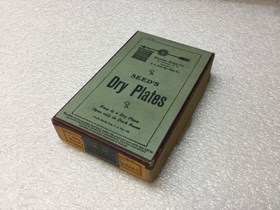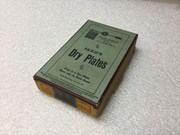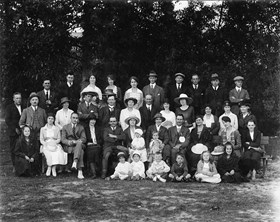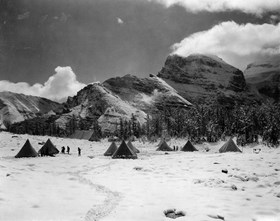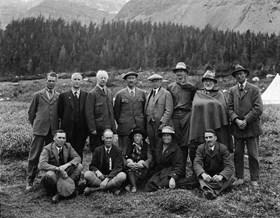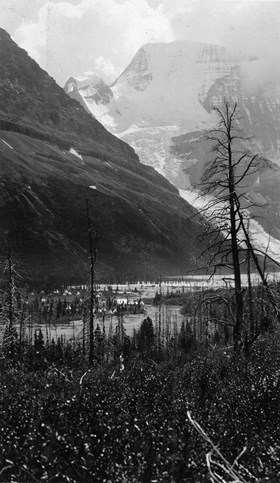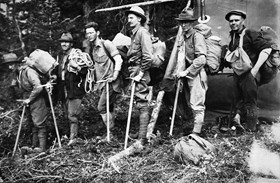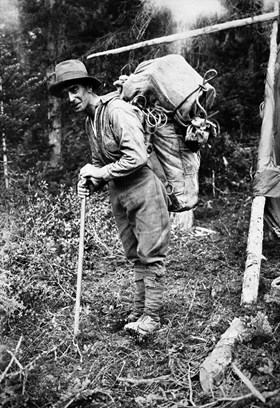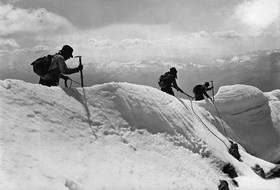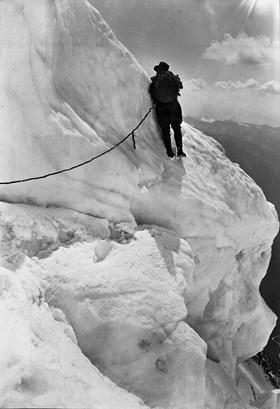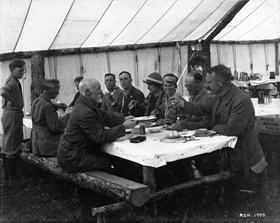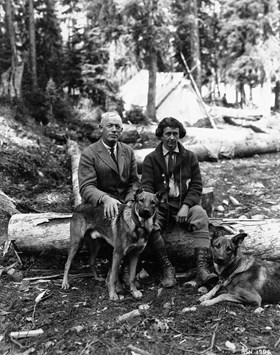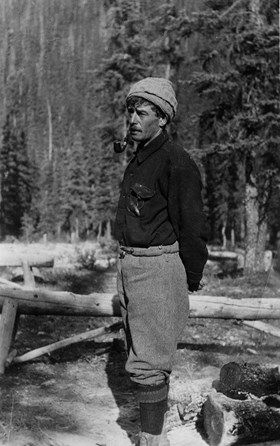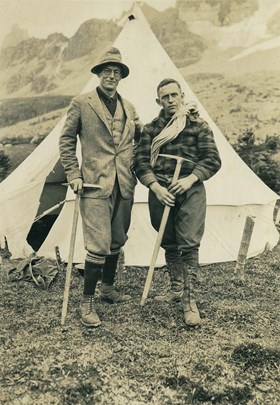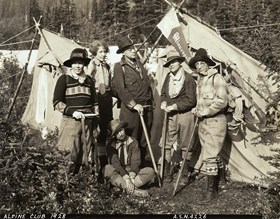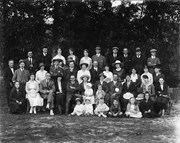Narrow Results By
- Alpine Club of Canada fonds 20
- Luxton family fonds 10
- Jimmy Simpson family fonds 6
- Underwood and Underwood Publishers fonds 5
- Byron Harmon fonds 4
- Caroline Hinman fonds 4
- Jim Brewster family fonds 3
- Canadian Pacific Railway fonds 2
- Elliott Barnes fonds 2
- Parks Canada fonds 2
- Arthur Oliver Wheeler fonds 1
- Brett family fonds 1
Watercolour Paper
https://archives.whyte.org/en/permalink/artifact104.41.0275
- Date
- c. 1923
- Material
- paper;
- Catalogue Number
- 104.41.0275
- Description
- A green-ish booklet of watercolour papers. Stapled at the left side, the text on the front of the booklet reads “Nicholson’s Peerless Japanese Transparent Water Colors” (in a decorative font), “COMPLETE EDITION” “FIFTEEN COLORS” (on the right side), along the bottom “ “THE SELF-BINDING COLORS” ”. T…
1 image
- Title
- Watercolour Paper
- Date
- c. 1923
- Material
- paper;
- Dimensions
- 8.8 x 20.5 cm
- Description
- A green-ish booklet of watercolour papers. Stapled at the left side, the text on the front of the booklet reads “Nicholson’s Peerless Japanese Transparent Water Colors” (in a decorative font), “COMPLETE EDITION” “FIFTEEN COLORS” (on the right side), along the bottom “ “THE SELF-BINDING COLORS” ”. There is a stamp of a mythical creature in black. On the back side of the booklet, “THE ORIGINAL AND ONLY” “PEERLESS” “JAPANESE TRANSPARENT WATER COLORS” “THE WORLD-FAMOUS” “SELF-BLENDING WATER COLORS”, a signature “Chas. F. Nicholson” in a fancy cursive font, and vertically along the spine “MADE IN U.S.A.” The inside of the booklet features many pages with information on the product, instructions to use, and a price sheet for more products. There are fifteen colours in the booklet, “BRILLIANT YELLOW” “DEEP YELLOW” “ORANGE YELLOW” “FLESH TINT” “GERANIUM PINK” “JAPONICA SCARLET” “ROYAL CRIMSON” “MAHOGANY BROWN” “SEPIA BROWN” “LIGHT GREEN” “DARK GREEN” “SKY BLUE” “DARK BLUE” “WISTARIA VIOLET” “PEARL GRAY”. In between each piece of watercolour paper, is a normal sheet of paper with information on each colour and Japanese (?) script. Some colours have been used, such as the yellows, greens and blues.
- Credit
- Gift of Pearl Evelyn Moore, Banff, 1977
- Catalogue Number
- 104.41.0275
Images
This material is presented as originally created; it may contain outdated cultural descriptions and
potentially offensive content.
Read more.
- Date
- c. 1910
- Material
- leather; metal; glass; wood; plastic; textile
- Catalogue Number
- 104.41.0249
- Description
- Buster Brown box camera with brown leather handle. Solid structure with black textile covering made to resemble leather. The front of the camera has a hole that likely once held a lens. There are two smaller holes in the upper corner of the front, which contain small glass parts. There is also meta…
1 image
- Title
- Box Camera
- Date
- c. 1910
- Material
- leather; metal; glass; wood; plastic; textile
- Dimensions
- 13.5 x 9.7 x 15.9 cm
- Description
- Buster Brown box camera with brown leather handle. Solid structure with black textile covering made to resemble leather. The front of the camera has a hole that likely once held a lens. There are two smaller holes in the upper corner of the front, which contain small glass parts. There is also metal hardware holding the front exterior panel to the structure. One side has a round hole with glass held by metal hardware, creating a viewfinder. There is also a metal winding mechanism, and a lever for the shutter release. The lever activates a mechanism that quickly uncovers and then re-covers the inner lens. The rear part of the camera has a small round, red-tinted window that would have shown the number for the section of film in position. At the top is a metal hinge that can be lifted to open the back panel, which comes down and is connected with a textile hinge. The top of the camera has a leather handle attached with metal pegs. The leather handle is worn, but you can see that it has been engraved by the manufacturer with the text: “No. 2A BUSTER BROWN”. There is also a viewfinder on the front corner. When the metal latch is opened, the rear panel opens and the interior cartridge can be seen. Pulling out the handle of the winding mechanism on the side of the camera releases the cartridge so that it can be removed. It’s a wooden box with a lens on the front and it has compartments for spools that hold the film. There is a spool in one side, but the other is empty. There are also two metal rollers that would hold the film in place. One side of the wooden cartridge is engraved with the following text: “MFD. BY”; “ANSCO COMPANY”; “BINGHAMTON, N.Y.”; “U.S.A.”; “PATENTED”; “JUNE 23 1903”; “SEPT. 20 1910”; “OTHER PAT. PENDING”; “FOR 6A OR 6B FILM”. Above the engraving is some handwriting in pencil that reads “6-A”; “2 1/2 x 4 1/2”. link to pdf of user manual: http://www.cameramanuals.org/agfa_ansco/ansco_buster_brown_camera.pdf
- Credit
- Gift of Don Harmon, Banff, 1985
- Catalogue Number
- 104.41.0249
Images
This material is presented as originally created; it may contain outdated cultural descriptions and
potentially offensive content.
Read more.
- Date
- 1905 – 1927
- Material
- wood; metal; fabric
- Catalogue Number
- 104.41.0248 a-d
- Description
- A wooden tripod made by Eastman Kodak company. 3 sets of wooden legs that fold and slide out to extend - brass detailing and screw-knobs. The top of the tripod is a circular disk with brass detailing on the bottom to attach the legs, and the top of the disk has brown felt for where the camera would…
1 image
- Title
- Camera Tripod
- Date
- 1905 – 1927
- Material
- wood; metal; fabric
- Dimensions
- 112.0 x 18.0 cm
- Description
- A wooden tripod made by Eastman Kodak company. 3 sets of wooden legs that fold and slide out to extend - brass detailing and screw-knobs. The top of the tripod is a circular disk with brass detailing on the bottom to attach the legs, and the top of the disk has brown felt for where the camera would sit. Dimension for d) 3.3 x 15.4 x 15.4 cm
- Credit
- Gift of Don Harmon, Banff, 1985
- Catalogue Number
- 104.41.0248 a-d
Images
This material is presented as originally created; it may contain outdated cultural descriptions and
potentially offensive content.
Read more.
Exposure Plates
https://archives.whyte.org/en/permalink/artifact104.41.0207
- Date
- 1902 – 1920
- Material
- cardboard; paper; glass;
- Catalogue Number
- 104.41.0207
- Description
- Box of one dozen 3 1/4 x 5 1/2 glass Seed’s Dry Plates with cut paper adhesive tape around the edges and bottom and manufacturer details printed on a pale green background throughout the lid. These dry plates were invented by M.A. Seed in 1879 and became very popular with photographers as the plate…
1 image
- Title
- Exposure Plates
- Date
- 1902 – 1920
- Material
- cardboard; paper; glass;
- Dimensions
- 3.0 x 9.3 x 15.0 cm
- Description
- Box of one dozen 3 1/4 x 5 1/2 glass Seed’s Dry Plates with cut paper adhesive tape around the edges and bottom and manufacturer details printed on a pale green background throughout the lid. These dry plates were invented by M.A. Seed in 1879 and became very popular with photographers as the plates came pre-prepared with the emulsion layer already applied - prior to “dry” plates, photographers would need portable dark rooms in which they would create their liquid emulsions prior to taking a photograph [known as “wet” plates]. Seed’s dry plates still required they be opened in a dark room, but this could be accomplished in the field by placing a dark sheet over the camera while loading and unloading the plates. In 1902, Eastman Kodak purchased Seed’s company [Seed Dry Plate Co.], but continued to capitalize on his name due to its reputation among consumers.
- Credit
- Gift of Robert Crosby Family, Banff, 1998
- Catalogue Number
- 104.41.0207
Images
This material is presented as originally created; it may contain outdated cultural descriptions and
potentially offensive content.
Read more.
Folding Camera
https://archives.whyte.org/en/permalink/artifact104.41.0237
- Date
- ca. 1922 – 1932
- Material
- metal; leather; glass
- Catalogue Number
- 104.41.0237
- Description
- Black hard-sided leather No.1 Kodak Series III folding camera. The front panel is released by pressing a small round metal button on the narrow bottom edge [the bottom of the camera is noted by the presence of a threaded hole where a tripod could be mounted] and has a small rectangular metal foot w…
1 image
- Title
- Folding Camera
- Date
- ca. 1922 – 1932
- Material
- metal; leather; glass
- Dimensions
- 17.1 x 7.8 x 3.5 cm
- Description
- Black hard-sided leather No.1 Kodak Series III folding camera. The front panel is released by pressing a small round metal button on the narrow bottom edge [the bottom of the camera is noted by the presence of a threaded hole where a tripod could be mounted] and has a small rectangular metal foot with “Kodak” engraved in decorative writing that keeps the camera propped up. The lens mechanism slides out on tracks with soft black leather bellows behind it and a viewfinder that can be used in portrait and landscape by gently push to the side. There is a art-deco decorated stylus housed next to the lens. There is lots of text along the lens to make adjustments, it is a “DIOMATIC No 0” lens. There are small plaques along the camera base which read “NO. 1 - KODAK SERIES III” “MADE IN CANADA BY CANADIAN KODAK CO., LIMITED TORONTO, ONT 28981”. The back panel of the camera pops off by pressing two metal clasps on both short sides and can house a roll of film. On the back embossed is text that reads “USE “KODAK” FILM NO A120” When the camera is open, on the top is a leather strap with a faded “Kodak” embossed on it.
- Credit
- Gift of L. A. E Duncan, Calgary, 1980
- Catalogue Number
- 104.41.0237
Images
This material is presented as originally created; it may contain outdated cultural descriptions and
potentially offensive content.
Read more.
Folding Camera
https://archives.whyte.org/en/permalink/artifact104.41.0245
- Date
- 1905 – 1927
- Material
- metal; leather; glass; wood
- Catalogue Number
- 104.41.0245
- Description
- A large, black leather bound square folding camera from Eastman Kodak Co. The camera when folded looks like a leather case with a leather handle attached at the top with two large metal buttons. One of the shorter sides features varying mechanisms to make adjustments to the camera. At the top is re…
1 image
- Title
- Folding Camera
- Date
- 1905 – 1927
- Material
- metal; leather; glass; wood
- Dimensions
- 24.6 x 23.0 x 10.0 cm
- Description
- A large, black leather bound square folding camera from Eastman Kodak Co. The camera when folded looks like a leather case with a leather handle attached at the top with two large metal buttons. One of the shorter sides features varying mechanisms to make adjustments to the camera. At the top is rectangular shaped metal plate with a knob that can be twisted and will make a clicking noise with a engraved arrowed to indicate turn the knob counter-clockwise, underneath is a l-shaped leaver that has a minor turn radius with an “M” engraved on the one arm. In the middle is a gold metal knob that can be pushed away from the case to open the one side and reveal the camera. Near the knob is a metal plate that reads “SPEED GRAPHIC CURTAIN APERTURE”, a graph with numbers, and “FOLMER & SCHWING DIVISION” “EASTMAN KODAK CO.” “13476 ROCHESTER, N.Y.” At the bottom is another square-shaped plate with a knob that can be turned that corresponds to numbers in a small black circle in the plate. On the top of the case is a white sticker with blue numbers “68622”. On the back of the case is a section for film holders/double dark slides and a glass plate behind a piece of the case that opens with a clasp at the bottom of the square. The other short side features small metal circles and a hole for a screw - most likely for a tripod mount. The front of the case is flat. When the case is opened it reveals the folded camera with black bellows and a silver metal face with a Wollensak Betax No.3 lens. It moves on a track to extend and retract with a mechanism in the front that when pinch together allows for the movement of the camera. There is a partially ripped sticker on the wood panel that reads “Sales - Service - Repairs” “Camera & Instrument Crafts” “9452 Calgary, Alta.” One side of the panel also features a black plate with numbers for focal range.
- Credit
- Gift of Don Harmon, Banff, 1985
- Catalogue Number
- 104.41.0245
Images
This material is presented as originally created; it may contain outdated cultural descriptions and
potentially offensive content.
Read more.
Folding Camera
https://archives.whyte.org/en/permalink/artifact104.41.0280
- Date
- c. 1910
- Material
- wood; metal; leather
- Catalogue Number
- 104.41.0280
- Description
- A small black box folding camera. On the top of the camera is a set of two hinged latches which open the back panel of the camera (the leather is separating from the camera). There is also a bump on the top of the camera that when pressed releases the front panel of the camera that reveals the fold…
1 image
- Title
- Folding Camera
- Date
- c. 1910
- Material
- wood; metal; leather
- Dimensions
- 11.5 x 8.0 cm
- Description
- A small black box folding camera. On the top of the camera is a set of two hinged latches which open the back panel of the camera (the leather is separating from the camera). There is also a bump on the top of the camera that when pressed releases the front panel of the camera that reveals the folding lens, tracks, and a viewfinder near the top of the panel. There is no lens, and the silver metal lens holder is separated from the red bellows. On the other side of the front panel is a hole which a tripod can be screwed into. There are also two small holes on either side of the camera near the top, possibly for a strap.
- Credit
- Gift of Catharine Robb Whyte, O. C., Banff, 1979
- Catalogue Number
- 104.41.0280
Images
This material is presented as originally created; it may contain outdated cultural descriptions and
potentially offensive content.
Read more.
Folding Camera
https://archives.whyte.org/en/permalink/artifact104.41.0281
- Date
- 1906 – 1916
- Material
- wood; metal; leather
- Catalogue Number
- 104.41.0281
- Description
- A medium-sized black box folding camera. The top of the camera features a leather handle stamped with “PREMO” in the middle attached with two silver clasps, a circular black and red sticker with white text that reads “FILM” “THE” “PREMO” “CAMERA” “NO.1”, a set of two silver metal latches that open …
1 image
- Title
- Folding Camera
- Date
- 1906 – 1916
- Material
- wood; metal; leather
- Dimensions
- 16.0 x 12.1 cm
- Description
- A medium-sized black box folding camera. The top of the camera features a leather handle stamped with “PREMO” in the middle attached with two silver clasps, a circular black and red sticker with white text that reads “FILM” “THE” “PREMO” “CAMERA” “NO.1”, a set of two silver metal latches that open the back panel, and a small bump that opens the front panel of the camera. The back panel features a metal plate stamped with “U.S.A. PAT. NOV.10-03.” Once opened the back panel reveals the backside of the bellows and lens. On the interior of the panel the name “Bud Miller” is etched in, stamped text that reads “MANUFACTURED BY” “EASTMAN KODAK CO.” “SUCCESSORS TO” “ROCHESTER OPTICAL CO.” “ROCHESTER, N.Y. U.S.A.” “NO.” “1” “PREMO FILM”, etched “6257”, “PAT. JULY 8-1902” “NOV. 10-1903”. There is a black sticker with gold text that reads “The Kodak House” “BISHOP & CHRISTIE” “VANCOUVER, B.C.” When the front panel is released the lens, red leather bellows, focal range meter, and viewfinder. To extend the lens outwards, there are two silver latches that are pinched together. On the lens there is a shutter speed adjustment at the top, “T” “B” “I”, and along the bottom is an aperture adjustment “128” “64” “32” “16” “8” “4”, above the aperture range is text that reads “Eastman Kodak Co. Succ’rs to” “ROCHESTER OPTICAL CO.”. The viewfinder can be shifted from portrait to landscape.
- Credit
- Gift of Catharine Robb Whyte, O. C., Banff, 1979
- Catalogue Number
- 104.41.0281
Images
This material is presented as originally created; it may contain outdated cultural descriptions and
potentially offensive content.
Read more.
Folding Camera
https://archives.whyte.org/en/permalink/artifact104.41.0282
- Date
- 1917 – 1926
- Material
- metal; plastic; leather
- Catalogue Number
- 104.41.0282
- Description
- Black hard-shelled leather, No.2 Folding Autographic Brownie Kodak camera. The front panel is released by slide a metal switch open, which also acts as the stand for the camera. When opened it reveals the lens, black leather bellows, and focal range on the right side. The lens locks into one of two…
1 image
- Title
- Folding Camera
- Date
- 1917 – 1926
- Material
- metal; plastic; leather
- Dimensions
- 16.5 x 8.7 cm
- Description
- Black hard-shelled leather, No.2 Folding Autographic Brownie Kodak camera. The front panel is released by slide a metal switch open, which also acts as the stand for the camera. When opened it reveals the lens, black leather bellows, and focal range on the right side. The lens locks into one of two spots on the focal range meter, with a small lever on the side of the lens. On top of the lens is the viewfinder which can be pushed to the side, for portrait or landscape. The lens is marked with a lot of text, shutter speed on top and aperture underneath (which includes the type of scenario for each aperture), such as “PORTRAIT 4” “NEAR VIEW” “AVERAGE VIEW 8” “DISTANT VIEW 16” “MARINE 32” “CLOUDS 64”. Along the edge of the lens text reads “KODAK BALL BEARING SHUTTER”. Underneath the lens reads, “NO. 2 FOLDING” “AUTOGRAPHIC” “BROWNIE”. To load the film, when the front panel is closed there is longer metal bar that can slid to the right that releases the main part of the camera, which can be taken out fully. Inside the camera is a few pieces of tape. Along the edges of the camera are different dates for patents. On the right side of the camera is a leather handle, which reads “No. 2 FOLDING AUTOGRAPHIC BROWNIE”, and a silver ‘key’ to reel the film. The back of the camera features a metal bar on a hinge that reads “USE AUTOGRAPHIC FILM” “NO. A-120” and a art-deco decorated stylus above, this reveals a part of the film to be autographed. There is also an orange circle to view the film inside.
- Subject
- film photography
- photography
- camera
- Kodak
- Whyte
- Credit
- Gift of Catharine Robb Whyte, O. C., Banff, 1979
- Catalogue Number
- 104.41.0282
Images
This material is presented as originally created; it may contain outdated cultural descriptions and
potentially offensive content.
Read more.
A. W. Drinnan photographs
https://archives.whyte.org/en/permalink/descriptions7237
- Part Of
- Alpine Club of Canada fonds
- Scope & Content
- Album and loose accompanying prints pertain to alpine club camps and activities.
- Date Range
- [ca. 1917-1928]
- Reference Code
- V14 / AC 192P / 01-10
- Description Level
- 5 / File
- GMD
- Photograph
- Photograph print
21 images
- Part Of
- Alpine Club of Canada fonds
- Description Level
- 5 / File
- Fonds Number
- M200 / S6 / V14
- Series
- III. Personal papers and photographs
- Sous-Fonds
- V14
- Accession Number
- 5200
- Reference Code
- V14 / AC 192P / 01-10
- Responsibility
- Album was assembled by A.W. Drinnan; includes many views by H. Pollard.
- Date Range
- [ca. 1917-1928]
- Physical Description
- 1 photograph album (ca.180 prints). -- 9 photographs : prints
- Scope & Content
- Album and loose accompanying prints pertain to alpine club camps and activities.
- Name Access
- Alpine Club of Canada
- Drinnan, A. W.
- Subject Access
- Abbot Pass Hut
- Activities
- Administration
- Advertising
- Alpine Club of Canada
- Alpine Club House
- Cabins
- Cabins and shelters
- Camps
- Club
- Competition
- Discovery and exploration
- Environment
- Environment and Nature
- Exploration
- Guide
- Guides
- Hiking
- Huts
- Mountain
- Mountain guides
- Mountaineering
- Mountaineers
- Mountains
- National parks and reserves
- Organizations
- Photography
- Scenery
- Sports and recreation
- Summit
- Geographic Access
- Banff National Park
- Jasper National Park
- Yoho National Park
- Alberta
- British Columbia
- Canada
- Language
- English
- Title Source
- Title based on album
- Processing Status
- Processed
Images
This material is presented as originally created; it may contain outdated cultural descriptions and
potentially offensive content.
Read more.







